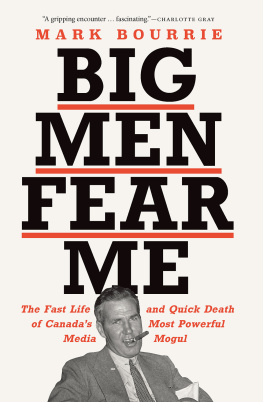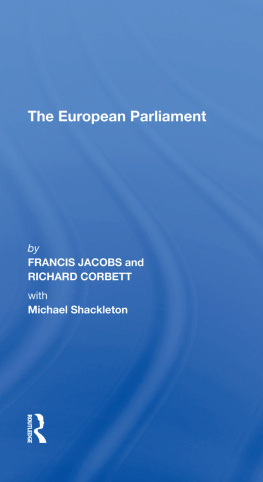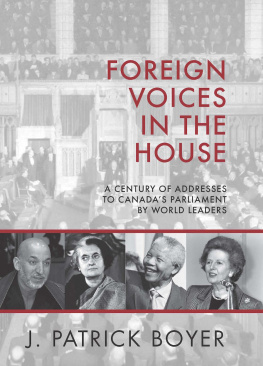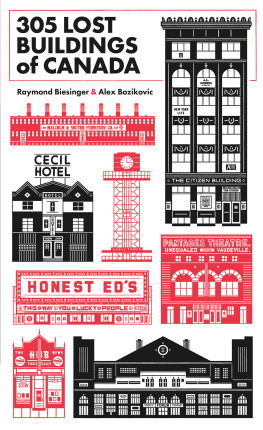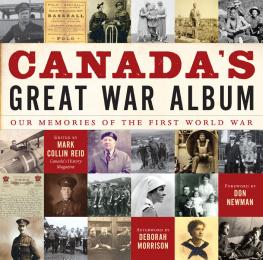Canadas Parliament Buildings
Copyright 1996 by Mark Bourrie
All Rights Reserved. No part of this publication may be reproduced, stored in a retrieval system, or transmitted in any form or by any means, electronic, mechanical, photocopying, recording, or otherwise (except for brief passages for purposes of review) without the prior permission of Hounslow Press. Permission to photocopy should be requested from the Canadian Reprography Collective.
Hounslow Press
A member of the Dundurn Group
Publisher: Anthony Hawke
Editor: Liedewy Hawke
Designer: Sebastian Vasile
Printer: Webcom
Front Cover Photograph: Andy Shott
Canadian Cataloguing in Publication Data
Bourrie, Mark, 1957-
Canadas Parliament Buildings
ISBN 0-88882-190-5
1. Parliament Buildings (Ottawa, Ont.) - History.
I. Title.
NA4415. C220726 1996 725'.11'0971384 C96-930601-6
Publication was assisted by the Canada Council, the Book Publishing Industry Development Program of the Department of Canadian Heritage, and the Ontario Arts Council.
Care has been taken to trace the ownership of copyright material used in this book. The author and the publisher welcome any information enabling them to rectify any references or credit in subsequent editions.
Printed and bound in Canada.
Printed on recycled paper.

Hounslow Press
2181 Queen Street East
Suite 301
Toronto, Ontario, Canada
M4E 1E5
Hounslow Press
73 Lime Walk
Headington, Oxford
England
OX3 7AD
Hounslow Press
250 Sonwil Drive
Buffalo, NY
U.S.A. 14225
Acknowledgements
The author is indebted to many people of the Parliament Hill community: Heather Bradley, Andy Shott, and Audrey Dube of the Office of the Speaker of the House of Commons; House of Commons Speaker Gilbert Parent, who explained to me the importance of the parliamentary mace and its history; the staff of the House of Commons tour guide program, who rarely knew when I would attach myself to one of their trips through the buildings; Jean-Marc Cariffe of the Prime Ministers Office; the National Archives of Canada and the National Library of Canada; the staff of the Canadian Parliamentary Press Gallery, with a special thanks to Nelson Laframboise, Terry Guillon, and Joyce Kingston-Viens; Arthur Milnes, a treasure house of Canadian political lore; Rosaleen Dickson of the Hill Times, who provided interesting information about the Great Fire of 1916.
There is no way that this book could have been completed without the help of the generous and kind staff of the Library of Parliament; my editor, Liedewy Hawke; my publisher and friend, Tony Hawke, and, above all, my wife Marion, who keeps it all together.
Introduction
The voice of the people is said to be as the voice of God.
House of Commons,
Petition to King James I, 1604
The idea that the voice of the people holds wisdom, or should even be listened to, is not new. In small places, where people know one another and can judge for themselves the wisdom in the words of their neighbours, democracy is a system that arises fairly naturally. Nomadic groups, such as the aboriginal hunters of the Canadian subarctic and plains, have to be limited in size since hunting is an unpredictable and rather tricky way of making a living. Most hunting bands are made up of only a family or two, acting the way any family would. Ideas are shared, disagreements are worked out through argument, promises are made. If people arent satisfied with the way things are going, they may simply leave the group. Anyone holding responsibility does so with the direct consent of the governed, and, if the people dont like the way things are run, the leader works out the problem with the unhappy followers, steps aside, or watches as his former friends pack up and go.
People who live on farms have a more stable food supply. If there is a surplus, populations rise. Towns and cities can be created. As a society becomes more complex, its members no longer know everyone in their region. Class systems arise, people compete for control of commerce and territory, citizens expect protection, and armies are created to protect the society from foreign invasion.
Most early states were simply tyrannies, developed to force people to do the bidding of a few leaders. The voice of the people can never be kept silent for very long, however. In time, the will of the people, their demand to be heard, has crumbled all of the great police states. Pharaohs, Greek city state tyrants, Caesars, absolute monarchs, Jacobins, all once terrified their citizens. Now theyre gone, most often remembered only as part of high school history exams. Nazis, Communists, Peronists, Fascists, too, are fading, or have already left historys stage. Yet our one-thousand-year-old parliamentary system survives, flourishes, and is copied and adapted in most places that have embraced democracy. Canadas parliamentary system has roots that go back far into the history of Europe and North America. We think of Canada as a new country, but it is one of the worlds oldest parliamentary democracies. Some of the democratic ideas that are embedded in our political system took shape here before Europeans began colonizing North America.
Canada is the largest area ever to be governed by a truly democratic government. Our constitution envisions Canada as a federal state, meaning that power is shared between provincial governments, each representing the interests of a separate region, and a central government, which is expected to govern for the benefit of Canada as a whole.
The Parliament of Canada is a complex institution that uses written law, as well as the unwritten traditions of the British system, to determine how it is to function. Parliament is not just the House of Commons. It embraces the queen, represented in Canada by the governor general, along with the Senate, and the House of Commons. In theory, at least, the three branches of Parliament balance each other. Members of the ministry, who are the executive of the government, may be members of either the elected House of Commons or the appointed Senate. Ministers are selected by the prime minister, who also chooses the departments for which they will be responsible, but the prime minister must inform and consult the governor general, in the name of the queen. The governor general appoints the prime ministers choices, and, traditionally, new ministers are sworn in at Rideau Hall, the governor generals residence.
The buildings on Parliament Hill were built to be the physical centrepiece of this system. Their Gothic architecture is a reminder of the long history of the institution of Parliament. Inside, the political currents of our society are reflected by the ebb and flow of governments. Dramatic, colourful, brilliant, and, quite often, eccentric people, created these buildings and governed from them.
There is a sacredness within the walls of the old Gothic buildings. They are legislatures, offices, and meeting rooms. They are also shrines to our freedom. If anyone in the country really wants to feel like a Canadian, this little group of stone buildings is the place to visit. Good and bad governments come and go, but the hard-won right of the people to have their voice echo in the halls of Parliament endures, as it has down through the centuries.




